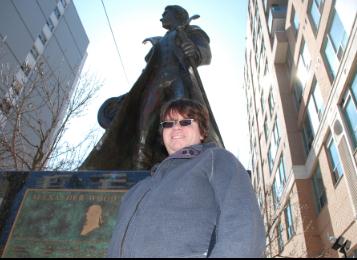Toronto’s gay village is viewed by many as the cultural epicentre of Canada’s gay rights movement, but as more development moves in and queer people move into other areas of the city, the community is rapidly changing.
One upcoming Jane’s Walk tour addresses these changes. Jane Farrow, former executive director of Jane’s Walk, is asking the question, Does a gay village still matter to the queer community?
Farrow, who is also part of a group currently conducting a study of the Church-Wellesley Village, says her walk is the perfect companion for the research.
“I’m really good at getting other people to talk,” she says. “I don’t necessarily have the answer. But when more people talk, the answer is inevitably of a better quality. More input and more voices makes a better product.”
Farrow says she loves that the Village is a colourful, sexy place and wants it to stay that way. “When you are queer and you can walk down the street and see a guy in a jockstrap and a leather mask. In the other direction is two girls making out. That’s an incredible feeling. It’s freedom . . . I don’t go to the Village that often, but I really need it to be there.”
Now in its sixth year, the Jane’s Walk weekend has grown into a Toronto spring tradition, an idea that has spread across Canada and to 18 countries and 90 cities, with 550 walks happening around the world, including 148 in Toronto.
The event honours Jane Jacobs, who encouraged citizens to get out and explore their neighbourhoods on foot.
Mathew Mac Lean, who is facilitating two different walks of Toronto’s gay village, hopes to celebrate the Village’s history and nightlife.
One tour of the Village meets at Wellesley Station and walks to Glad Day Bookshop. From there, the group heads to the Canadian Lesbian and Gay Archives, then over to the 519 Church Street Community Centre, the AIDS Memorial, the former Barn nightclub, the Alexander Wood statue and the former Club Toronto, which is now Oasis Aqua Lounge. The walk ends in Allan Gardens.
“I stop here and there to offer bits of history, such as the 1981 bathhouse raids and the protests that erupted in the following days,” says Mac Lean, who started Toronto Queer Walking Tours three years ago. “It’s those moments that brought the community together and created a movement.
“I tell people that was the day we really took back the power, and we started to really mobilize.”
Unlike Farrow’s walk, Mac Lean stays clear of current Village politics. “We go by Loblaws, but I don’t go into what Loblaws has done to the Village,” he says.
Later, after the sun goes down, Mac Lean will lead a tour of Church Street’s bars and clubs. “I want people to see what the Village is like at night. During the day, you really wouldn’t know it’s a gay village. It’s like a regular downtown community now.
“And that’s why it is so important we still have a Village. We need that nightlife.”

 Why you can trust Xtra
Why you can trust Xtra


